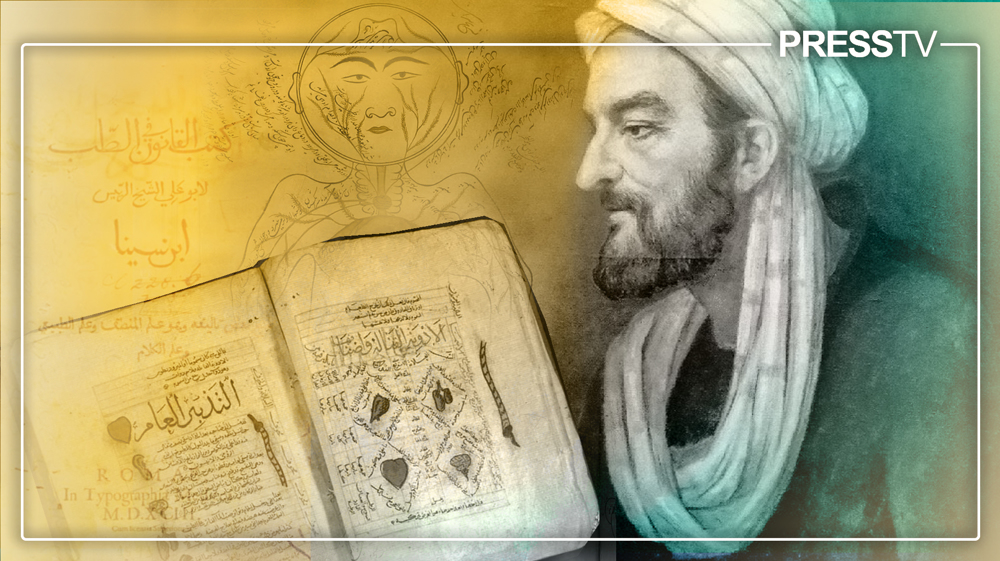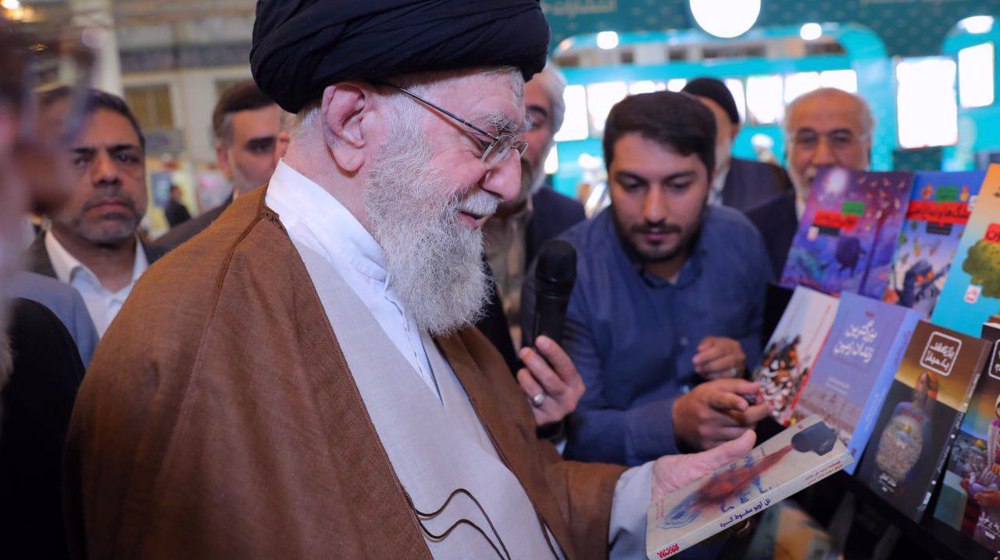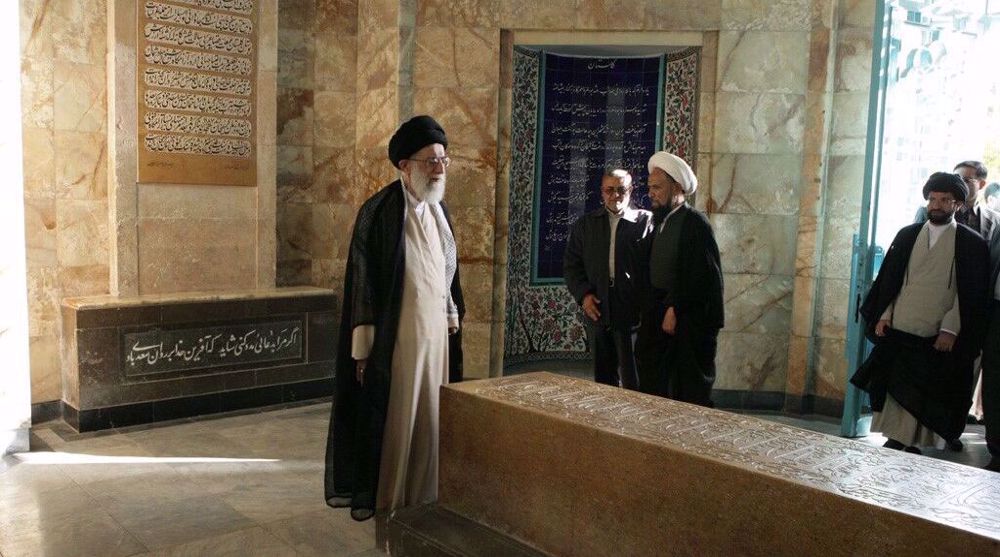Remembering Ibn Sina, Iranian genius who mesmerized world with his wisdom
By Humaira Ahad
Guarded by the mighty Alvand peaks in the historic Iranian city of Hamadan, 330 km southwest of Tehran, lies the magnificent mausoleum of one of the giants of Islamic civilization – Ibn Sina – known in the West by the Latinized name ‘Avicenna’.
The spindle-shaped building that houses the tomb of Ibn Sina also contains a museum and a library, the enclosure being surrounded by lush green gardens, probably the way he would have liked it.
Abu Ali al-Hussain ibn Abdullah al-Balkhi was born in 980 CE in the village of Afshana in present-day Uzbekistan. The philosopher, physician, mathematician, astronomer and scholar, Ibn Sina is widely recognized today as the “father of modern medicine”.
“The museum gives a peep into Ibn Sina’s life. It is surreal to see the tools that were used by the world’s greatest physician,” Sonia, a tourist visiting the mausoleum from France, told the Press TV website.
“The various herbs displayed here take you back hundreds of years to the time when this genius physician would treat patients,” she added.
Ibn Sina’s Persian father was a bureaucrat in the ruling Samanid Empire. Having a privileged upbringing, he received a good education and, by the age of 10, had memorized the entire Qur’an and later dedicated his life to the study of medicine, philosophy, astronomy, music and other sciences.
In addition to being the father of modern medicine, Ibn Sina is also known as one of the most influential philosophers of the pre-modern era.
Well-versed in early Islamic, Pre-Islamic, Persian, Greek and Oriental philosophy, Ibn Sina contributed significantly to Islamic thought and is regarded by some as the “founder of scholastic philosophy in its systematic formulation.”
Abu Ubayd Jozjani, a disciple and biographer of Ibn Sina, writes that the polymath lived a comparatively unstable life due to the irregular political and social environment of the time. He had to change places constantly until he found stability in Isfahan, a city in central Iran.
Most of the 220 works that are attributed to him were completed in Isfahan.
Ibn Sina the physician
One of Ibn Sina’s famous works, “Al-Qanun fi al-Tibb”, also known as “The Canon of Medicine” is an extensive encyclopedia of medical knowledge from ancient sources. It was translated into Latin in the 12th century and was used as a university-level reference up to the 17th century in Europe.
As the most authoritative book on medicine, it has overshadowed all medical books authored by writers in medieval Europe for centuries and continues to be a source of reference for all medical practitioners.
Many of the practices that were started by Ibn Sina were carried out throughout the East and the West. For example, in the absence of modern-day antiseptic, he used wine for dressing wounds.
He identified anthrax and diagnosed diabetes at a time when blood tests did not exist.
“Ibn Sina explained the relationship between mind and body and for the first time described how psychological diseases like depression can lead to physical ailments,” Dr. Iram, a psychologist working in Tehran, told the Press TV website.
The system of quarantine which was experienced by the world during the Covid-19 pandemic has its roots in Ibn Sina’s method of Al-Arbainiya (forty in Arabic).
The world-renowned Persian physician understood that some diseases are caused by microorganisms, prescribing self-isolation for infectious individuals to contain the spread of the illness.
“Ibn Sina explained the anatomy of body parts including the human heart at a time when dissection of the human body was considered a sin and called for capital punishment,” Dr. Ali Kirmani, an Internal Medicine specialist from Oman, told the Press TV website.
“His anatomical description of the human body revolutionized the medical practice.”
Ibn Sina the philosopher
Ibn Sina’s remarkable work “Kitab Al-Shifa” (The Book of Healing) is considered as the largest and most comprehensive encyclopedia ever written by a single author.
Being a devout Muslim, Ibn Sina spent a lot of time reading Islamic scriptures as well as Greek philosophy in order to prove the existence of the Almighty using both disciplines.
Explaining the existence of God, Ibn Sina came up with “Burhan Al-Siddiqin” (Proof of the Truthful). In this seminal book, he argued that God is the "necessary existent" or something that cannot not exist.
An expert on mathematics and astronomy, Ibn Sina devoted a major part of his book “Al-Shifa” to these two disciplines, providing new perspectives from the scientific point of view.
The celebrated physician contributed to the field of physics significantly. He argued that light had a specific speed, and explained how sound traveled through the air, and also gave a theory on motion.
“In Kitab Al-Shifa, Avicenna had presented fundamental principles of geology in terms of earth processes, major events and long geologic time,” writes Munim Al Rawi in his paper on Ibn Sina’s contribution to earth sciences.
“Those principles were later known in the Renaissance of Europe as the law of superposition of strata, the concept of catastrophism, and the doctrine of uniformitarianism.”
Rawi added that the history of geology in Europe sees Leonardo da Vinci as a near-universal genius, however, da Vinci’s ideas were already embodied in Ibn Sina’s work in “Kitab Al-Shifa”, 400 years prior to da Vinci’s birth.
Ibn Sina worked extensively on the ideas of the eminent Greek philosopher Aristotle.
“I admire his clear understanding of philosophy, which happens to be a deep area of knowledge. He worked to strengthen Islamic philosophy, drawing on Aristotelian philosophy initially then moving ahead of it, advancing to deepen and modernize Islamic philosophy,” Dr. Seyed Amir Akrami, Assistant Professor at the Institute for Humanities and Cultural Studies, Tehran, told the Press TV website.
Ibn Sina the mystic
Henry Corbin, Iranologist and theologian regards Ibn Sina as a mystic, translating his seminal works “Risalat Hayy ibn Yaqzan”, “Risalat Al-Tayr”, and “Risalat Salaman wa Absal” into French and providing a mystical-gnostic interpretation of his allegorical writings.
“Ibn Sina’s “Maqamat Al-Arifin” is mystical in nature. He has discussed mysticism (erfan) philosophically and provided essential explanations of significant mystic terms including Zahid, Aabid, Arif,” said Dr. Akrami.
Ibn Sina’s appreciation for Aristotelian philosophy (Western Philosophy) and his interest in mysticism (Oriental philosophy) made him write “Kitāb Al-Inṣāf”.
The light was a strong metaphor for wisdom in Ibn Sina’s mystical writings, a symbol that was elaborated further by later philosophers, such as Ghazali and Suhrawardi.
For Louis Massignon, the famous French Islamicist, Ibn Sina through his work on Oriental philosophy, desired to "realize reconciliation between Greek philosophy, eastern falsafa, and Semitic wisdom, hikmah.”
Amongst the scholars who raised objections to certain elements of Ibn Sina’s philosophy, Ghazali finds a particular mention. However, Michael E. Marmura, a Palestinian scholar on Islam, says that for Ghazali, “philosophy for all practical purposes meant Ibn Sina’s philosophy.”
“Ibn Sina is considered one of the greatest Islamic philosophers despite being controversial, all original thinkers have had to face some form of criticism and Ibn Sina is no exception to that. He made some original contributions to medieval Islamic thought,” Dr. Mufti Mudassir, writer and professor of English literature at Kashmir University, told the Press TV website.
"No philosophical enterprise is final and absolute. Ibn Sina's greatness doesn't lie in his infallibility but in his creative approach to the problems of philosophy in his times,” he added.
Ibn Sina the poet
In addition to The Canon, Ibn Sina has left behind some other works in medicine, the most important of which is “Al-Urjuza fi l-Tibb”, written in the format of poetry in 1326 verses.
Being very ingenious in poetry and eloquence, Ibn Sina composed a long poem called “Al-Qasidat Al-'Ayniyya”, about the story of the human soul, “Qasidat Al-Jamana Al-'Ilahiyya fi l-Tawhid”, about monotheism, and “Al-Qasidat Al-Muzdawaja Fi l-Mantiq” on logic.
He focused on theoretical aspects of music at a time when music was considered an applied discipline.
His other works also include parts dedicated exclusively to music.
“Daring a critical estimate of the status of Ibn Sina, a towering genius of Islam in terms of his contributions to Islamic civilization, his eclecticism and gestalt flew him very high but too much faith in rationality and mental faculties weakened him and took him not where he wanted to go in the proximity of God,” Prof. Habib Rezavi, writer and poet who has written several books on mysticism, told the Press TV website.
In Ramadhan of 1037, the gifted physician and philosopher, passed away at the age of 58, leaving behind an illustrious legacy. His final resting place in Hamadan is a tourist attraction today
VIDEO | Several detained at Texas Capitol rally condemning police violence at pro-Palestine demos
IRGC: Raeisi's epic, inspiring role must always remain alive
ICC prosecutor seeks arrest warrant for Netanyahu
Tehran: Martyrdom of president, foreign minister will not disrupt Iran's policy
Inquiry into UK infected blood scandal to reveal findings
WHO chief: Supplies of essential medicines, fuel into Gaza ‘very low’
For Martyr President Raeisi, Palestine was the primary issue of Muslim world
VIDEO | Libya against Israeli regime at ICJ










 This makes it easy to access the Press TV website
This makes it easy to access the Press TV website